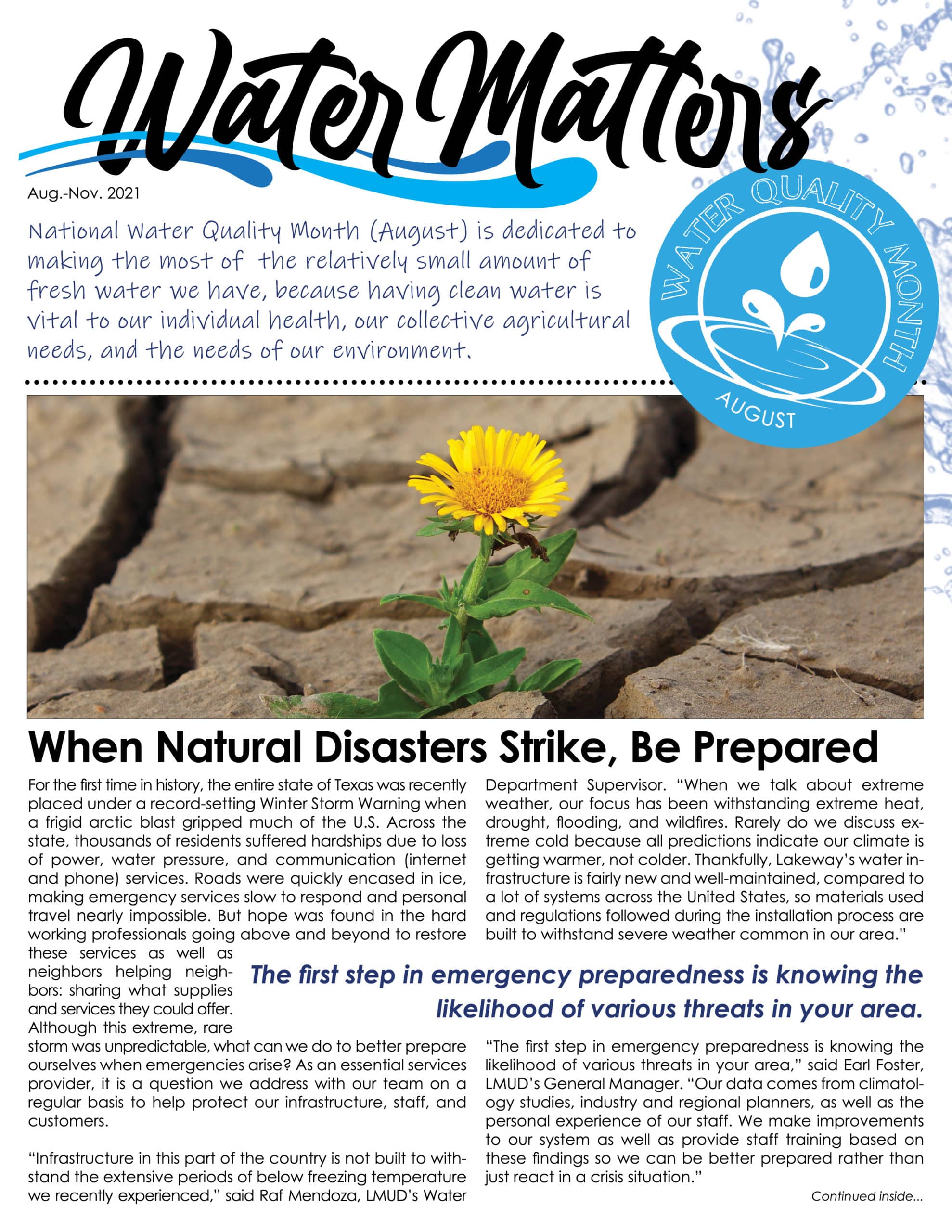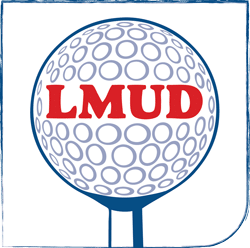Water Matters: Aug-Nov 2021 edition

[icon name=”file-pdf-o” unprefixed_class=”red”] Printable Version
National Water Quality Month (August) is dedicated to making the most of the relatively small amount of fresh water we have, because having clean water is vital to our individual health, our collective agricultural needs, and the needs of our environment.
When Natural Disasters Strike, Be Prepared
For the first time in history, the entire state of Texas was recently placed under a record-setting Winter Storm Warning when a frigid arctic blast gripped much of the U.S. Across the state, thousands of residents suffered hardships due to loss of power, water pressure, and communication (internet and phone) services. Roads were quickly encased in ice, making emergency services slow to respond and personal travel nearly impossible. But hope was found in the hard working professionals going above and beyond to restore these services as well as neighbors helping neighbors: sharing what supplies and services they could offer. Although this extreme, rare storm was unpredictable, what can we do to better prepare ourselves when emergencies arise? As an essential services provider, it is a question we address with our team on a regular basis to help protect our infrastructure, staff, and customers.
“Infrastructure in this part of the country is not built to withstand the extensive periods of below freezing temperature we recently experienced,” said Raf Mendoza, LMUD’s Water Department Supervisor. “When we talk about extreme weather, our focus has been withstanding extreme heat, drought, flooding, and wildfires. Rarely do we discuss extreme cold because all predictions indicate our climate is getting warmer, not colder. Thankfully, Lakeway’s water infrastructure is fairly new and well-maintained, compared to a lot of systems across the United States, so materials used and regulations followed during the installation process are built to withstand severe weather common in our area.”
The first step in emergency preparedness is knowing the likelihood of various threats in your area.
“The first step in emergency preparedness is knowing the likelihood of various threats in your area,” said Earl Foster, LMUD’s General Manager. “Our data comes from climatology studies, industry and regional planners, as well as the personal experience of our staff. We make improvements to our system as well as provide staff training based on these findings so we can be better prepared rather than just react in a crisis situation.”
“We’ve learned, however, that our own preparedness can only take us so far. It’s really a continual community effort that helps keep the impact of disasters to a minimum,” said Stephanie Threinen, LMUD’s Public Information Liaison. “For a small utility, we publish a lot of information to help educate our customers about maintaining their home’s plumbing system because it can greatly impact our ability to continue providing reliable water and wastewater services. For example, putting grease down drains cannot only clog a home’s plumbing, but if it reaches our mainlines, can cause a clog that impacts a whole neighborhood! Conservation is also key; all of our raw water comes from Lake Travis and with predicted hotter temperatures and longer periods of drought, there could easily be water shortages.”
Emergency preparedness is something everyone can do to help protect their assets and family. Knowing which threats are more likely in your area during different times of year can help you know how to prepare. For example, in Central Texas severe weather threats typically include:

Extreme heat has the highest weather-related fatality rate. Texas summers are long with highest average temperatures occurring in July and August, often reaching 100 degrees Fahrenheit for several days in a row.
Flooding is common near rivers and low-lying areas. In fact, some meteorologists proclaim Austin and the outlying Hill Country as “Flash Flood Alley,” the worst area in the country for intense flooding. The wettest months of the year are April and May with average annual precipitation ranging from 21 to 35 inches.
Drought in Texas is much more likely during La Niña. La Niña, or the cooling of South Pacific Ocean water temperatures, translates to warmer, drier atmospheric conditions for much of the South that peak through fall and winter seasons. Because of these dry conditions, much of western Austin and Travis County are at high risk for wildfire. Lake levels can also quickly drop with too little precipitation to replenish them.
Thunderstorms can bring dangerous lightening and damaging hail. These storms can happen any time of year, but are most common in the spring.
Tornados are possible, but not common. “Tornado Alley” stops short of Central Texas. The most likely time to see a tornado in Texas is March, April, and May.
The old Lone Star adage, “If you don’t like the weather, just wait a day, it will change” rings true, but as we recently experienced, the aftereffects of a few short days can last a much longer time. Stay prepared, neighbors and plan ahead! •
Originally written by LMUD for Lake Travis View, published February 2021
Spotlight! Reducing Wildfire Risks

An excellent resource on how to track your wildfire risk reduction accomplishments.
“Not if, but when” is a common stance held by those involved in fire and rescue. Thankfully, wildfires have been a rare occurrence in Lakeway, but with the long, hot summers, any dry vegetation can quickly act as kindling for the smallest spark. Lake Travis Fire Rescue (LTFR) invites local residents to sign up for the free Home Ignition Zone Assessments as part of their Wildfire Readiness Program which, they hope, will help minimize the impact of a wildfire when (not if) one occurs. For information, e-mail wildfire@ltfr.org.
Consider This
Since stormwater is not treated, it can pick up and carry pollutants into our waterways. Many of these pollutants can cause problems in very small amounts. Polluted stormwater runoff is often considered a non-point source pollutant, meaning that it comes from such varied and widespread sources across the landscape that it is difficult to identify where the pollution starts.

Fact
Even though water makes up over 70% of Earth’s surface area, the total amount of freshwater found on Earth only makes up around 3% of the water supply, 1% of which is easily accessible. This 1% accounts for all of our lakes, rivers, groundwater, aquifers, and streams.
8 Things You Can Do at Home to Protect Your Water
- Wash your car at a car wash: Even though it might cost more than washing your car at home, taking your car to a car wash saves water and prevents toxic chemicals from being flushed down your storm drains that eventually empty into our lakes, rivers, streams, and oceans Professional car washes are legally required to drain into sewer systems so that the water can be treated before being re-used.
- Pick up after your pet: Animal waste is full of nitrogen which can remove oxygen from the water leaving it completely unusable for aquatic life.
- Don’t hose down your driveway; use a broom.
- Don’t use fertilizer made with phosphorus: After heavy rainfall or watering, these chemicals can leak into nearby groundwater sources. Try using organic materials or waiting for drier weather if you absolutely need to use lawn care products.
- Do not flush expired or unwanted medication down the toilet: These products have toxic chemicals that should not be flushed down the drain.
- Properly dispose of used oil or antifreeze by taking it to a service station or recycling center.
- Avoid using antibacterial soaps or cleaning products in your drain as they are also toxic to marine life.
- Use a rain barrel to collect rainwater: Installing a rain barrel will not only save you money, but can also be used for watering your lawn or washing your car.
For more information on National Water Quality Month, visit nationalwaterqualitymonth.org.
Updates
LMUD APPROVES SELF INSTALLS FOR ODWW PROJECT
In response to a rapid influx of requests for an Early Connection to the Lakeway Municipal Utility District (LMUD) public sewer system from eligible property owners, and in an effort to increase the availability of approved connection requests within a specified time frame, LMUD approved the option of performing Self-installs of a grinder pump system. Approval is based on the feasibility of completing any required main line extensions within the property owner’s desired time frame. For property owners choosing an LMUD-install, an anticipated connection date based on the current project schedule will be provided at the time of approval, however this date is not guaranteed and will be adjusted based on factors such as weather, supply availability, urgency of need, and other potential project delays. More information is available at lakewaymud.org/odww-project.
81 ACRE LAND SALE TO LEGEND COMMUNITIES PENDING
HSD – Lakeway Holdings, LLC exercised their first extensions in March 2017; extension fees are in addition to and not applicable to the closing or sales price. Parcel 1 closed in April 2021. The next closing, on Parcel 2, is scheduled for January 2022. The last parcel is scheduled for closing in September 2022. For updates and a timeline of events, visit lakewaymud.org/update/timeline-of-lmud-land-sale-of-81-acres.
2020 WATER QUALITY REPORT RELEASED IN JUNE
Public water systems, like LMUD, are required to follow strict standards and submit regular reporting to local and federal authorities. Most public water systems, including LMUD, treat water above these standards. Each summer, by federal and state laws, public water systems are required to develop a Consumer Confidence Report (CCR) and distribute it to their customers. This annual water quality report provides residents information about the quality of their tap water. It includes information about the source of their water (ie: rivers, lakes, reservoirs, or aquifers), chemical contaminants, bacteriological contaminants, and more. A copy of this report was enclosed with our customer’s bill in June. To view the report, visit lakewaymud.org/ about-us/about-your-water.
AMI METER PILOT STUDY CONTINUES
We are currently in the process of improving our water meter reading system. The pilot study, initiated in July 2020, is testing the advantages of Advanced metering infrastructure (AMI) water meters: high-tech water meters with capabilities beyond what our current automated meter reading (AMR) water meters can offer our staff and customers. Unlike AMR meters, which we read every two months, AMI meter are continually read, opening up the possibility of detecting leaks earlier and getting feedback to customers on their water usage sooner. We are studying the new meters for their accuracy, reliability, and depth of available real-time data. Once the study’s findings are presented to and approved by the board, we will move ahead with fully implementing the system by hiring subcontractors to change out the remaining meters throughout our service area.
Do you know your irrigation schedule?
VISIT:
lakewaymud.org/customers/irrigation-schedule
Customer Comments
To everyone at LMUD who spent many hours making sure water was available or being restored to all of us during the terrible weather. Thank you for risking your own safety for all of us to be able to stay at home safely.
– Dennis and Patt, RE: Feb. Winter Storm
Thank you for your patience with all our questions and always getting us answers. All the work you’ve done this year to communicate the what, when, how, and why has truly been appreciated.
– Frances, RE: ODWW Project
I appreciate you taking the time to break down the costs on a line by line basis… as usual you went the extra mile and gave a detailed breakdown.
– Dave B., RE: Clarification on rates





 You are now being redirected to the WaterSmart page.
You are now being redirected to the WaterSmart page.